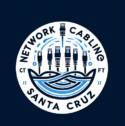What Are the Two Types of Cables Used in Networking?
When setting up a computer network—whether it’s for your business, home, or data center—it all starts with the right type of cabling. Network cables are the backbone that connects computers, servers, routers, and switches, allowing data to flow efficiently. But have you ever wondered what the two main types of cables used in networking are?
In this guide, we’ll explain the two primary cable types, how they work, and when to use each one to ensure your network runs smoothly and reliably. Our team of structured cabling professionals in Santa Cruz ensures every cable type is installed for maximum performance and compliance with industry standards.
The Two Main Types of Networking Cables
There are two primary categories of cables used in networking: Twisted Pair (Ethernet) cables and Fiber Optic cables. Both serve the same purpose—transmitting data between devices—but they differ in how they carry that data, their speed, and their ideal use cases.
1. Twisted Pair (Ethernet) Cables
Twisted pair cables are the most common type of networking cable found in homes, offices, and commercial spaces. They use copper wires twisted together to reduce interference and carry electrical signals that transmit data.
There are two main kinds of twisted pair cables:
- Unshielded Twisted Pair (UTP): Commonly used in standard Ethernet networks (Cat5e, Cat6, Cat6a).
- Shielded Twisted Pair (STP): Has additional shielding to protect against electromagnetic interference, ideal for industrial or high-interference environments.
Advantages of Twisted Pair Cables:
- Affordable and easy to install
- Supports high-speed data transfer up to 10 Gbps (with CAT6 or CAT6a)
- Widely compatible with most networking devices
- Ideal for short to medium distances
Common Uses:
- Home and office Ethernet connections
- IP cameras and VoIP systems
- Small to medium business networks
Popular Categories:
- CAT5e: Up to 1 Gbps, suitable for basic networks
- CAT6: Up to 10 Gbps over 55 meters, ideal for offices
- CAT6a: Improved shielding, supports 10 Gbps over 100 meters
If you’re setting up or upgrading your network, CAT6 cabling offers the best balance of performance and cost-efficiency.
2. Fiber Optic Cables
Fiber optic cables use strands of glass or plastic to transmit data as pulses of light instead of electrical signals. This allows for incredibly fast speeds and long-distance data transmission without signal loss or interference.
There are two main types of fiber optic cables:
- Single-mode fiber (SMF): Designed for long-distance communication, often used by ISPs and in large networks.
- Multi-mode fiber (MMF): Best for shorter distances, such as within buildings or campus networks.
Advantages of Fiber Optic Cables:
- Extremely high bandwidth and speed
- Immune to electromagnetic interference
- Can transmit over miles without signal degradation
- Supports future technologies like 40G and 100G Ethernet
Common Uses:
- Data centers and server rooms
- Internet backbone connections
- Hospitals, universities, and enterprise networks
- Inter-building or long-distance networking
While fiber optic cabling offers unmatched performance, it can be more expensive to install and requires specialized handling and equipment. When using Ethernet cables, distance plays a key role in maintaining speed and signal quality. Learn more about how long a LAN cable can be to ensure optimal setup.
Ethernet vs. Fiber: Which One Should You Choose?
The best choice depends on your specific needs:
| Feature | Ethernet (Twisted Pair) | Fiber Optic |
|---|---|---|
| Speed | Up to 10 Gbps (CAT6a) | Up to 100 Gbps or more |
| Distance | Up to 100 meters | Several kilometers |
| Cost | Affordable | Higher initial cost |
| Interference Resistance | Moderate | Excellent |
| Installation | Simple | Requires expertise |
For most home and small business networks, twisted pair Ethernet cables are sufficient. However, if you need long-distance or ultra-fast connectivity—such as for a data center, ISP, or large corporate network—fiber optic cabling is the superior choice.
Why Professional Installation Matters
Whether you choose copper Ethernet or fiber optic cabling, proper installation is key. Certified network cabling installers ensure cables are correctly terminated, tested, and compliant with both TIA/EIA standards and local building codes.
Professional installers in California, for example, must hold a C-7 Low Voltage Systems license, ensuring safe, efficient, and code-compliant installations for homes and businesses.
Upgrade Your Network with the Right Cable
Understanding the two main types of cables—twisted pair (Ethernet) and fiber optic—helps you make the best decision for your networking needs.
If you’re planning a new installation or upgrade, consult a professional structured cabling specialist to design a network that’s fast, secure, and ready for future technology demands. To understand data transmission better, explore which pairs are used for Ethernet and how they affect network efficiency.
Contact your local network cabling experts today to learn more about the right solution for your property and budget.
